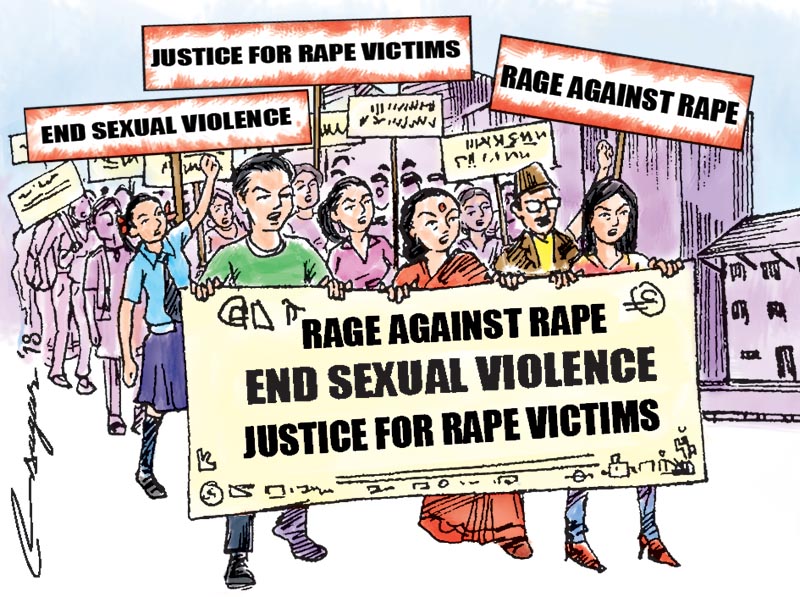Fighting sexual violence: Turn outrage into action
There is a need of strong political will and visible and unwavering commitment at the highest levels of leadership of the state, and the resolve, advocacy and practical action of individuals and communities to end violence against women
A young girl abducted and gang-raped by four men; a mentally unstable woman raped; girl raped by her ex-boyfriend; an online lover raped girl on first date; a teacher sued for raping his girl student; grandfather repeatedly raped his 8 year old granddaughter; a 7-year-old minor girl raped, murdered and buried by her cousin brother; a 9-month-old child raped and murdered… such are the news items we have come across in recent months. These are very worrying signs.
In the past seven years, 6,627 cases of rape were reported to Nepal Police. Of them, 4,589 were cases of rape and 2,038 were attempted rape. Every year, 946 cases of rape are reported, 78 each month. Estimates suggest one in every three women are sexually assaulted at some point of their lives. The number could be even higher, as some cases of sexual violence go unreported, largely because of the stigma attached to it. Rape victims and their families go through unimaginable psychological and social trauma. The prevailing mindset, which tends to further victimise the victims, often forces the rape victims and families to maintain silence.
With limited access to justice, possibility of a botched investigation, like in the case of Nirmala Panta of Kanchanpur, the psycho-social trauma the victims face, the problem of rape crimes is just getting more complicated. Each year, more than a million people lose their lives, and many more suffer non-fatal injuries as a result of self-inflicted, interpersonal or collective violence. Overall, violence is among the leading causes of deaths worldwide for people aged 15–44 years.
Rape and other forms of sexual coercion directed against women take place in a variety of settings, including in the home, the workplace, schools, colleges, on the streets, public transport, hospitals, in the military, as well as in prisons and police custody.
Sexually violent acts include sexual assault, sexual exploitation, ritual abuse, child sexual abuse, rape within marriage or dating relationships; rape by strangers; unwanted sexual advances or sexual harassment; including demanding sex in return for favours; sexual abuse of mentally or physically disabled people, including the marriage of children; sexual abuse of children; forced marriage or cohabitation; denial of the right to use contraception or to adopt other measures to protect against sexually transmitted diseases; forced abortion; female genital mutilation, trafficking.
A perpetrator can have any relationship to a victim—could be a complete stranger, or by someone known and even trusted, such as a friend, colleague, family member, partner or ex-partner, medical professionals. Most common forms of violence against women are those performed by a husband or an intimate male partner. Approximately seven out of 10 of sexual assaults are committed by someone known to the victim, such as in the case of intimate partner sexual violence or acquaintance rape.
It is reported that one-third of married women have experienced emotional, physical, or sexual violence from their spouses in their marital relationship. Date rape is particularly prevalent on college campuses, where it frequently occurs in situations involving alcohol or other date rape drugs.
Rape has long been considered one of the worst of crimes. It is a deeply violating and painful experience for the survivor.
Why is it more shameful to be raped than to be a rapist? The social acceptance and support to the victim is low. Incidents of sexual violence are frequently covered by the news and portrayed in television shows. Women can’t live with dignity and hold their head up until and unless politically powerful people protect the rapists.
Sexual assault is never okay. Although some survivors may stay silent for years before sharing their stories, but this cannot be construed as acceptance of the crime, as various prevailing situations often force them not to speak up.
States have an obligation to protect women from violence, to hold perpetrators accountable and to provide justice and remedies to victims. There is a need of strong political will and visible and unwavering commitment at the highest levels of leadership of the state, and the resolve, advocacy and practical action of individuals and communities to end violence against women.
It is essential to provide comprehensive care to victims of sexual assault, medical care for the victims of sexual violence, clinical management of rape survivors, psychological care and support, counselling therapy. Changing people’s attitude and mentality towards women will take a long time, at least a generation and perhaps longer, but the movement should start now. Community activism by men is an important element in preventing sexual and physical violence against women. Raising awareness on the violence against women is a must.
Female awareness self-defence courses need to be designed to make women more aware, prepared, and ready for any situation in everyday life to avoid, interrupt and resist assault. The media should be actively involved in highlighting the cases related to violence. Police should be dedicated in finding the criminal(s) immediately. Most importantly, we must speak up and tell our stories and encourage others to come forward and join the fight against sexual violence.






